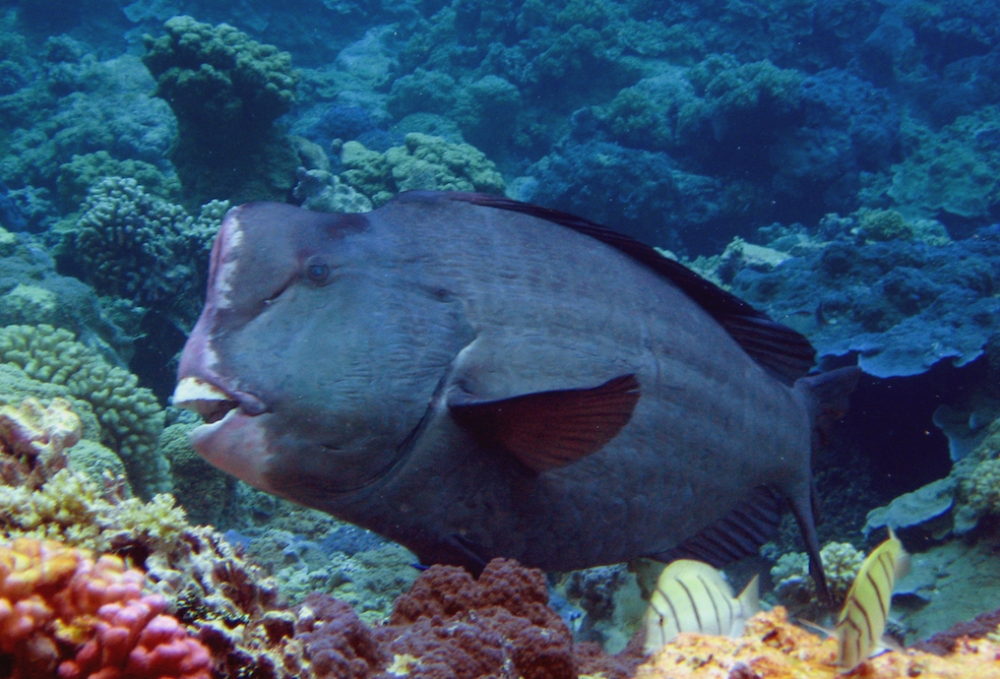
Reef Engineers

The next time you find yourself luxuriating in some exotic, Instagrammable vacation spot, thank a parrotfish. That white sand slithering between your toes? It consists mostly of their excrement.
But here’s another thing for which we can be grateful: our enhanced understanding of their environment’s system chemistry and system ecology.
In a study focused on the chemistry of the consumption and excretion of the bumphead parrotfish (Bolbometopon muricatum), UC Santa Barbara marine scientists sought to understand the relationship between the the massive, coral mega-consumers and the reef environments that serve as the fishes’ habitats as well as their sources of sustenance.
“They’re underwater elephants,” said Grace Goldberg, lead author of a paper published in the journal Coral Reefs. Similar to the huge land mammals, bumphead parrotfish are enormous. Reaching 1.4 meters in length, they are in fact the largest fish of their type and among the largest of coral reef fishes. Like elephants, the individuals consume a large volume — between 4.48 and 5.69 tons annually — of relatively low-quality food and subsequently excrete copious amounts of waste, the sheer amount of which shapes their environment, and, in the case of the tropical fish, gives nearby white sand beaches their defining feature.
“We think about coral reef systems as these stressed systems under climate change,” Goldberg said. “And these fish, because they’re so big, drive a lot of reef processes through their interaction with the coral and the physical reef environment.” To understand how they forage is to get a better picture of the complex dynamics that shape the reefs and the communities they support.
But while it’s common knowledge that environments and the species therein influence each other to some degree, the extent of this relationship can now be defined at a molecular level, with results that add new perspective to the study of coral reef ecology.
“What do we know about the raw materials of what they’re ingesting and what they’re pooping out?” Goldberg said.
To find out, the researchers collected fecal samples while swimming behind B. muricatum at the Palmyra Atoll in the heart of the Pacific Ocean. Bumphead parrotfish, unlike their fellow corallivorous cousins, dine almost exclusively on coral polyps and their calcium carbonate skeletons. Live coral (with polyps) and coral rock (just the hard skeleton) bites were also sampled in the process. The researchers used a chisel and calipers to remove a bite-sized chunk for analysis.
Then they turned to materials science. Using a differential scanning calorimeter, they probed their samples for their energy content, the same way chemists and materials scientists might investigate the energy content of coal and other fuels. They also used an elemental analyzer to determine the presence of nutrients and other elements relevant to the fish and the reefs.
The results? Coral rock, it turns out, contains about three times as many calories than live coral does. While the coral rock is considered “dead,” Goldberg said, other organisms colonize and recolonize the stony structures.
“It actually carries more nutrition and is full of life and full of calories,” she said. More work is necessary to understand what quantity of the nutrients the fish actually absorb into their tissues, Goldberg added, which may shed light on their foraging habits.
At the other end, bumphead parrotfish feces, unlike that of other fish and marine organisms, was not shown to generate any significant impacts on the chemistry of their coral reef environment.
The researchers’ findings contribute to a growing body of knowledge of coral reef ecology. The role of bumphead parrotfish in particular is complex. Their feeding habits contribute to the health of the reefs by consuming algae that compete with coral polyps for surface area. The fish also aid in the corals’ reproduction by opening up space and fragmenting the corals, which allows polyps to spread and colonize other sections of reef. But, their consumption of large amounts of coral and the potential of their prodigious amount of feces to smother parts of the reef could also be cause for concern, especially in an era of shrinking coral reefs. Because the bumpheads exert such a huge effect on the reefs they live in and feed on, they present an ecological puzzle to those who work to conserve the vulnerable fish and their sensitive, shrinking environment.
“We wanted to understand why it eats what it eats and what the implications of it might be for their environment,” Goldberg said of the multidisciplinary approach to studying the foraging habits of the bumphead parrotfish. “We’re trying to understand it in a really holistic way.”
Research on this study was also conducted by Hillary S. Young, Douglas J. McCauley and Paul Desalles of UC Santa Barbara; and Robert B. Dunbar and Fiorenza Micheli of Stanford University. Frank J. Millero and Ryan J. Woolsey of University Miami; Amy A. Briggs of University of Georgia; and Ted K. Raab of Carnegie Institution for Science also contributed research to this study.



